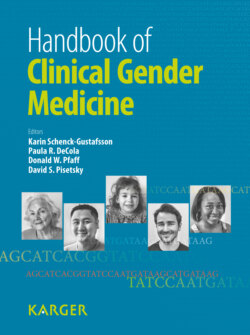Читать книгу Handbook of Clinical Gender Medicine - Группа авторов - Страница 127
Gonadal Steroids
ОглавлениеThe increased rate of depression in women during puberty, when gonadal hormone systems are activated, suggests that hormones may contribute to sex differences in depression. Research linking affective disturbances in women with periods of hormonal change – particularly during the premenstrual and postpartum periods – further reinforces this hypothesis.
It has long been debated whether the postpartum period is a time of increased risk for mood disorders, because the overall prevalence of depression does not appear to be higher in women after delivery compared with age-matched comparison women. Epidemiological studies have estimated the 12-month prevalence rate of major depressive disorder in women of childbearing age to be 12% [2], and a meta-analysis of 59 studies of postpartum depression (PPD) estimated a similar prevalence rate of 13% [17]. However, serious depression requiring admission to the hospital is clearly more prevalent following childbirth; Kendell et al. [18] found that the relative risk of psychiatric admission was extremely high during the first 30 days after childbirth and remained higher than it was before pregnancy for at least 2 years after giving birth. A Danish study compared the rates of hospital admissions or outpatient visits for mental disorders of more than 2 million adults and found that new mothers had a higher risk of depressive disorders during the first 5 months after giving birth [19].
Studies have failed to find consistent hormonal differences in women with and without PPD, leading researchers to hypothesize that the typical hormonal changes during the postpartum period may directly increase the risk of depression but only in some women. A study by Bloch et al. [20] used leuprolide in conjunction with high-dose estradiol and progesterone to create a scaled-down model of pregnancy and the puerperium. Using this model, investigators demonstrated that high-dose hormone add-back followed by abrupt withdrawal elicited dramatic depressive symptoms in euthymic women with a history of PPD. No mood symptoms were evident in women lacking that history. This study demonstrated that, despite the absence of consistent evidence of abnormal hormonal levels in women with PPD, gonadal steroids were nonetheless directly involved in triggering the depressive episodes in a susceptible population.
The hormonal changes throughout the menstrual cycle have also been implicated in affective dysregulation in women. Although many women report mild-to-moderate physical or emotional symptoms during the late luteal phase of their menstrual cycle, approximately 5–10% experience significant mood disturbances in the days prior to menses. This condition, known as premenstrual dysphoric disorder, like PPD, represents a differential affective response to normal fluctuations in steroid levels in a susceptible population. Although the source of this susceptibility is unknown, controlled, double-blind studies manipulating gonadal steroid levels have clearly demonstrated a role of estradiol and progesterone in a subset of depressions in women – those related to reproductive events – thus suggesting a possible sex-dependent source of variance in the etiopathogenesis of depression.
